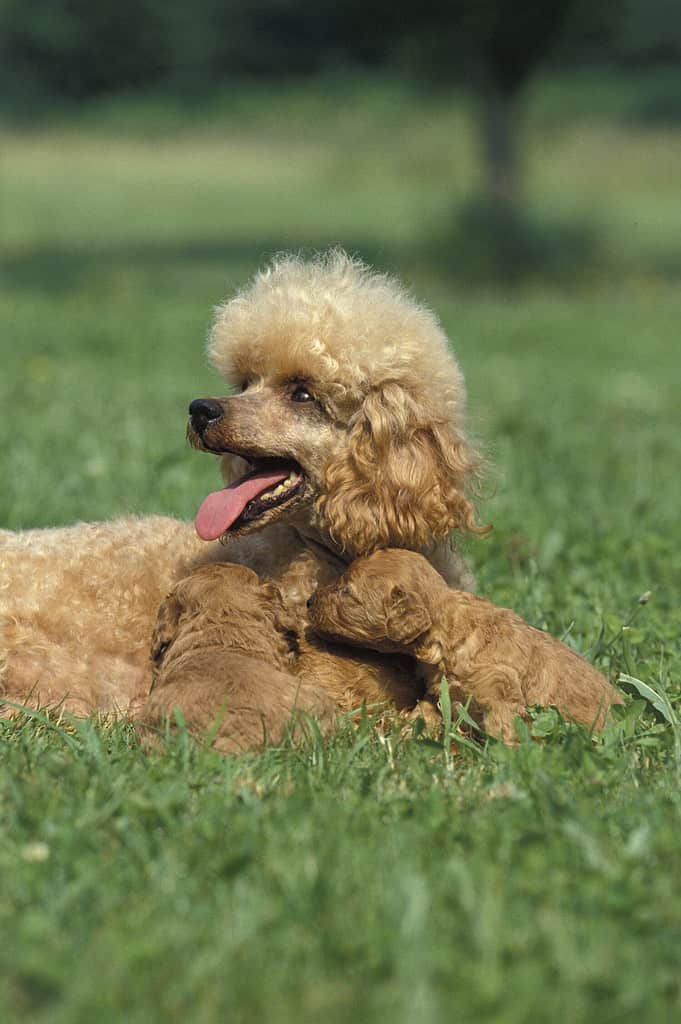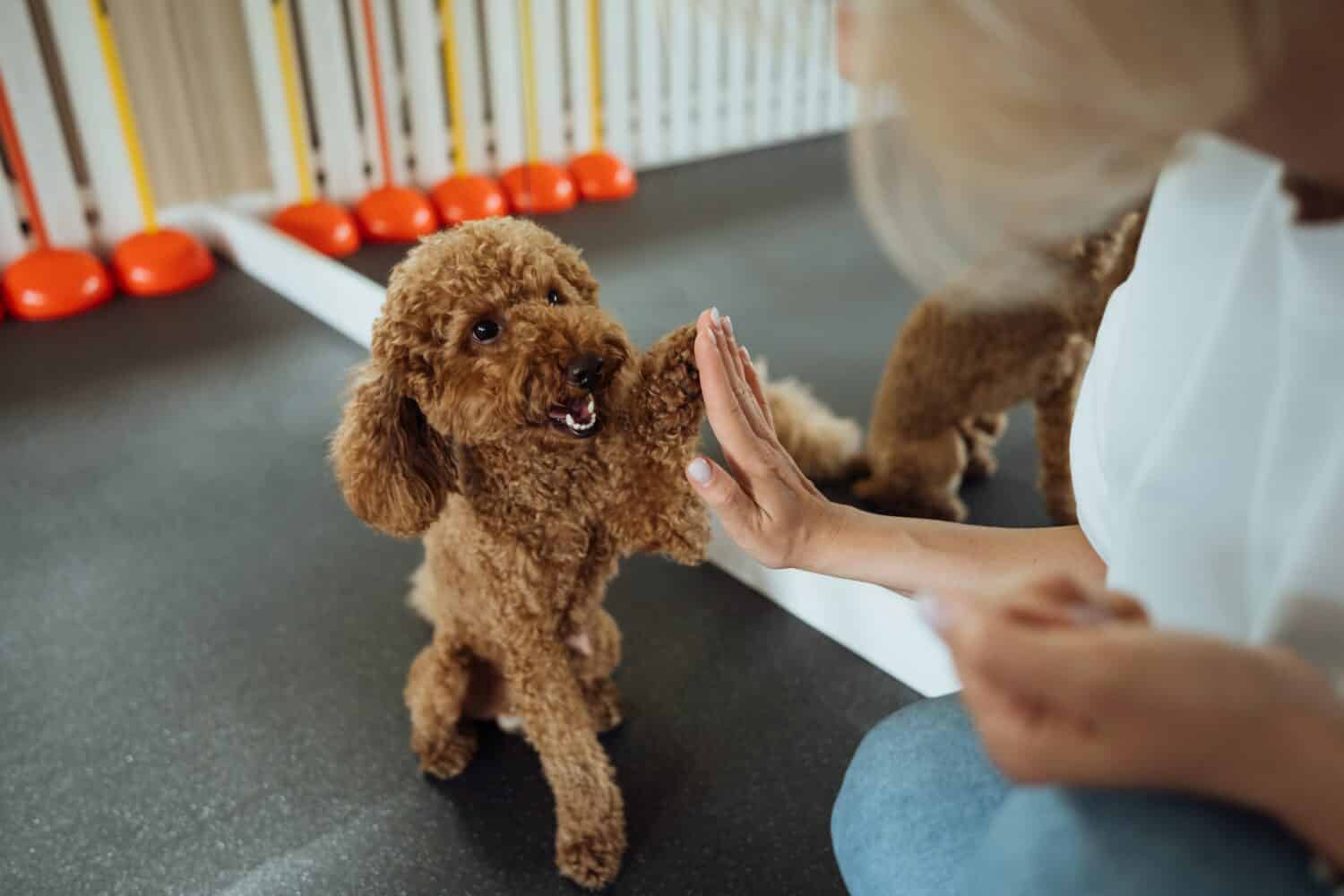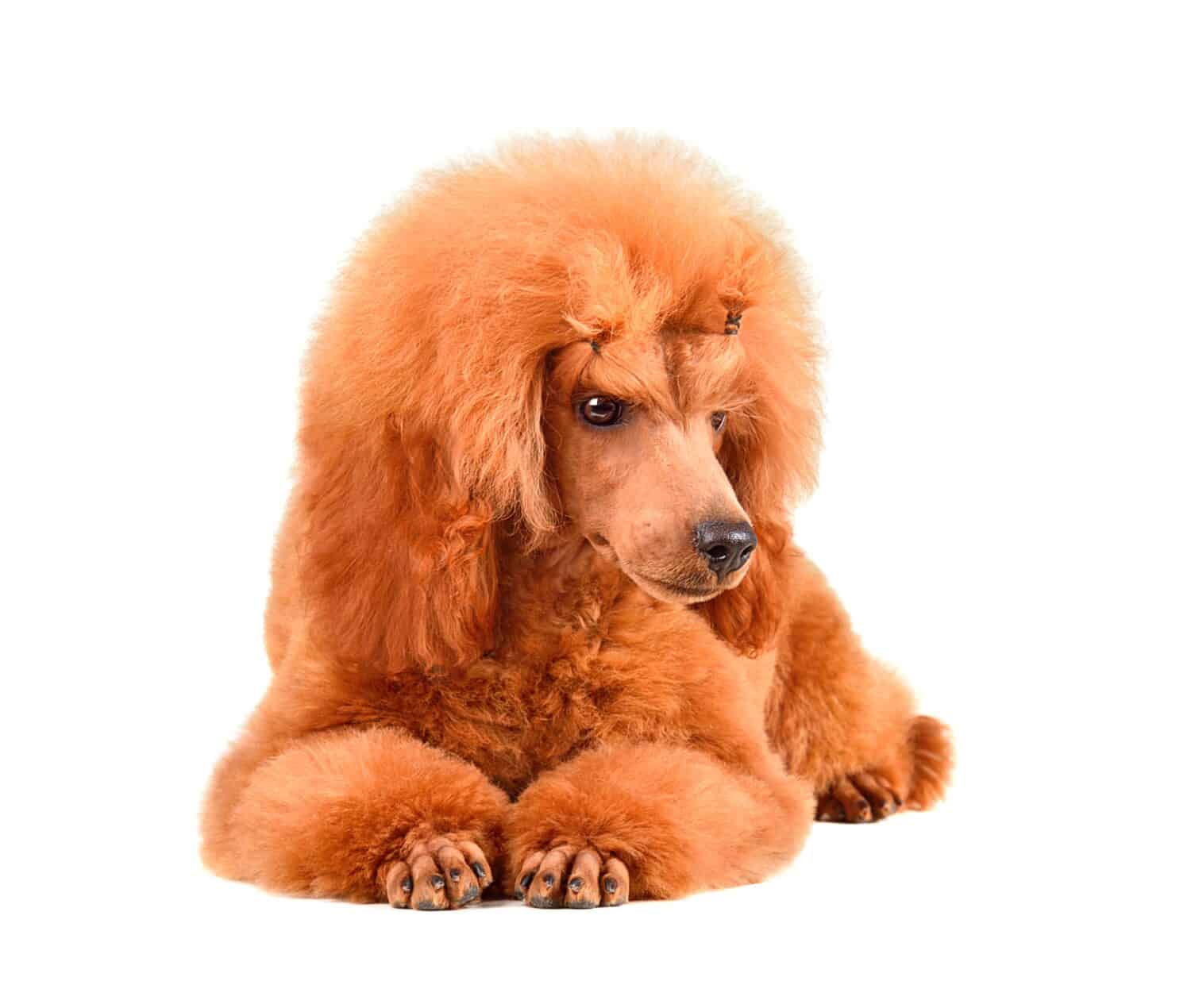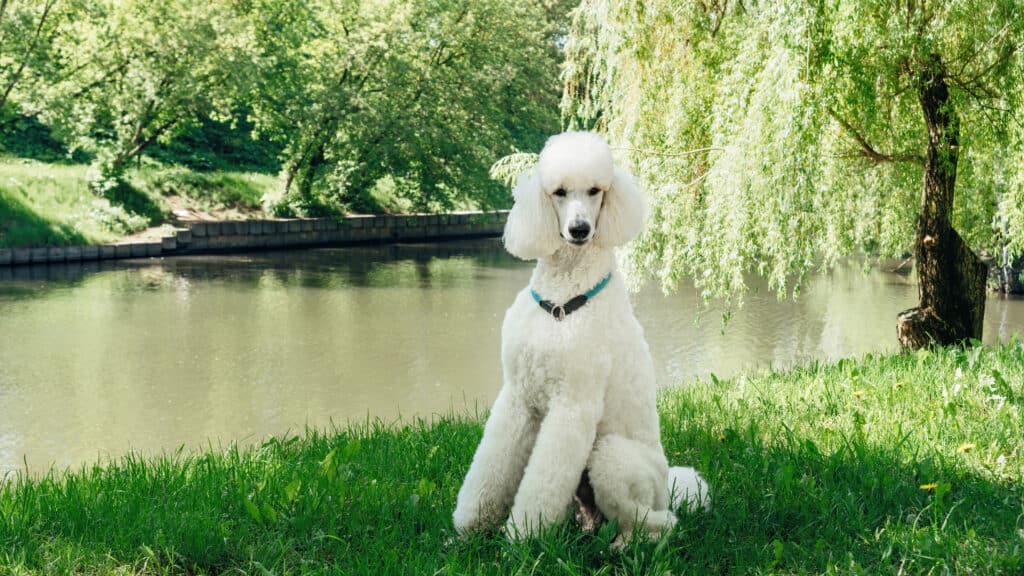Bringing home a new poodle puppy? Check out our guide to learn crucial information about what to expect from your poodle’s progression. We’ll also talk about the importance of raising them with compassion and gentleness.
Read on to learn more!
Poodle: Breed Summary
The earliest history of the poodle is a bit unclear, but historians mostly pinpoint 15th-century France or Germany as the origin location and era for this breed. The stance of the American Kennel Club (AKC) is that while the poodle is closely tied to France, and is indeed the country’s national dog, the breed first originated in Germany as duck hunters. While many folks today may not associate them as such, the standard poodle is a type of water retriever, and they excel in this discipline.
Breeders developed the famous curly coat and shave pattern of the poodle as protection against the cold and water. Traditionally, leaving the coat on certain vital areas of the body protected the poodle from the cold water, while shaving parts of the legs, neck, and tail allowed for freer swimming movement.
While the standard poodle excelled as a duck-hunting dog, the stunning breed also became well-loved and popular among the wealthy and nobility of Europe. With this increased popularity among non-hunters, breeders began also focusing on developing miniature and toy varieties as urban pets.
In 1887, the AKC formally recognized the miniature variety of poodles. These mini poodles, due to their notable intelligence and athleticism, became widely popular as circus performers across Europe.
In the early 20th century, the toy variety of the poodle first appeared in America. There, the toy and miniature varieties gained popularity as household pets and circus performers.
Some Breed Standards and Attributes
According to the AKC, the standard, miniature, and toy varieties should perfectly reflect each other with only a notable difference in size. This breed should be squarely built and well-proportioned in limb size, length, and musculature. The skull should be moderately rounded, ears should be fringed with fur and hang close to the head, and eyes should be very dark, oval, and express keen alertness and intelligence. The coat should be curly, dense, and with a coarse texture.
While many factors besides genetics can play a role in the personality of your dog, research does support some genetic influence on breed temperaments, behavioral tendencies, etc. The social environment, maternal care, early socialization and formative experiences, health, and how caregivers raise their pups also play roles in the behavioral expressions of dogs. With this in mind, you may note that poodles tend to be quite intelligent with a high aptitude to learn skills quickly. Poodles can also display an innate fondness for water and carrying items in their mouths.

A lovely poodle with a traditionally shaved coat.
©Dulova Olga/Shutterstock.com
Poodle Progression: Growth Chart by Age
The following chart details the average growth of a healthy standard male and female poodle from 8 weeks of age to 2 years. Since toy and miniature poodle growth, development, and milestones are quite different from standard poodles, we will focus only on standard poodles for the rest of this guide.
| Age | Female Standard Poodle | Male Standard Poodle |
|---|---|---|
| 2 Months | 11-16 pounds | 16-20 pounds |
| 3 Months | 16-20 pounds | 21-25 pounds |
| 4 Months | 19-23 pounds | 28-33 pounds |
| 5 Months | 22-27 pounds | 33-40 pounds |
| 6 Months | 26-32 pounds | 40-48 pounds |
| 7 Months | 30-34 pounds | 47-52 pounds |
| 8 Months | 33-36 pounds | 50-54 pounds |
| 9 Months | 35-38 pounds | 53-56 pounds |
| 10 Months | 36-39 pounds | 55-58 pounds |
| 11 Months | 38-40 pounds | 57-59 pounds |
| 12 Months | 40-42 pounds | 58-60 pounds |
| 18 Months | 42-45 pounds | 60-65 pounds |
| 24 Months | 45-50 pounds | 60-70 pounds |
When Will My Poodle Stop Growing and How Big Will They Be?
You can expect your standard poodle to reach their maximum height at around 12 months old, and their maximum weight at around 2 years old. A standard poodle must be over 15 inches tall at the withers per the AKC. Both male and female standard poodles reach on average between 18-24 inches at the withers by 12 months of age. While males and females can reach similar heights, there tends to be a much more notable difference in their weights. On average, male standard poodles weigh 60-70 pounds, while females weigh 40-50 pounds.
It’s crucial to provide appropriate puppy food for your poodle as they develop. Adult food does not supply enough of the essential nutrients that a growing puppy needs to properly develop. Additionally, it’s always important to provide plenty of fresh water.
Visiting your vet at the 2, 4, 6, 9, 12, 18, and 24-month mark will help ensure that your standard poodle is properly developing.

You can expect your standard poodle pup to reach their max height around 12 months of age and maximum weight around 2 years old.
©slowmotiongli/Shutterstock.com
Poodle Progression: When Should My Poodle Be Spayed or Neutered?
It’s important to speak to a vet who is educated and up-to-date on the latest spay and neuter research to help you make an informed decision about when to alter your poodle. You may also choose to not spay or neuter your pup, but the question is quite complex, especially in places like the US where 400,000 shelter dogs are euthanized every year. As such, if you do decide to keep your dog intact, please refrain from allowing your pet to breed, as this only furthers the crisis facing shelter dogs and puppies needing homes.
According to a recent large-scale study comparing intact dogs versus dogs altered under 1 year of age, standard male poodles are significantly more at risk of developing a cancer called lymphosarcoma when neutered at 1 year or earlier. While several large breed dogs are at increased risk of developing joint and bone diseases from early altering, standard poodles do not appear to face this risk.
In light of this research, your vet may recommend waiting to alter a male standard poodle until they are 18-24 months old. For female standard poodles, current studies do not indicate an increased risk of joint and bone diseases or cancers from early spaying. As such, your vet may be more comfortable with completing this procedure when your female poodle is under 1 year old.
Poodle Progression: When Should My Poodle Be Potty Trained?
You can begin potty training your poodle puppy at 8 weeks old. You’ll need to operate within your puppy’s biological parameters. At 8 weeks old, your pup can only hold their bowels for up to 2 hours. At 4 months, they can typically hold it for up to 4 hours. So, make sure you’re taking your puppy outside before they reach their maximum holding time. Additionally, you’ll want to take your puppy outside after they drink a lot of water and eat their meals.
Make sure to offer a lot of support, praise, connection, and tasty treats when your puppy goes to the bathroom outside. Connecting going outside with all of these positive experiences will help your poodle puppy learn that going to the bathroom outside is a wonderful activity. Using puppy pads at nighttime can prevent you from having to take them out at night. You can also use these pads to help transition your puppy to going outside during the day by bringing the pads outside with you.
If Your Poodle Puppy Goes Indoors
If you find that your poodle puppy is having accidents inside, it’s imperative to never scold or punish your pup. Any form of punishment will only teach your puppy that you are someone to be wary of. This can damage your relationship and make your puppy feel conflicted and anxious around you, as may want to connect with you but may also be scared of your responses. Additionally, punishing your puppy for having accidents indoors may push your puppy to hide where they are going since they won’t feel safe around you. Instead of using punishment, focus on building a safe connection and using rewarding education to help your puppy learn life skills.
Poodle Progression: When Should My Poodle Stop Eating Puppy Food?
Your standard poodle can transition to eating adult food around 16-18 months old. At this age, your poodle will have reached their max height and about 90% of their max weight. When you transition to feeding adult food, you can also switch to feeding 2x per day, although some dog guardians continue to feed lunch as enrichment.

You can transition your poodle puppy to adult food at 16-18 months old.
©Ermolaev Alexander/Shutterstock.com
When Will My Poodle Start Losing Teeth?
At about 4 months old, your poodle puppy should start losing their set of 28 puppy teeth. At this time, their set of 42 adult teeth will begin coming in. This process can be quite uncomfortable for your puppy, and they will likely seek out items to chew to alleviate this discomfort. It’s especially important to provide safe chewing items of various textures during this time. It’s also important to try to puppy-proof your house as much as possible to help prevent them from chewing inappropriate or unsafe items.
Trade, Don’t Take!
Make sure to trade, rather than simply take items away if you find that your puppy is chewing inappropriate items. If you only take things away from your puppy, they can understandably start feeling unsafe around you when they’re chewing something or eating. This can lead to long-term stress for your puppy who may start displaying guarding and defensive behaviors. Prevent this from occurring by providing lots of chew toys for your pup and by trading for tasty treats and chews, rather than just taking, if you find them chewing something inappropriate.
Poodle Progression: When Should I Start Training My Poodle?
You can begin rewarding education with your poodle puppy at 8 weeks old. These sessions should only be a few minutes long, fun, safe, and enjoyable experiences for your puppy. Rather than thinking about teaching “obedience”, I encourage new puppy caregivers to think about supporting their puppy in learning life skills in a human-dominated world. Your puppy needs care, guidance, and support in safely navigating our human world, but they don’t need or benefit from dominance, coercion, or obedience-centered learning.
At this young age, your poodle puppy is in the critical early socialization period. During this time from 3-12 weeks old, their brain is best wired to support curiosity and process new experiences, stimuli, and environments. A good rule of thumb during the 8-12 week period is to gently, supportively, and positively introduce your puppy to one new experience every day. This may be gentle social processing at a park, sniffing new items, feeling new textures under their feet, meeting other animals, etc. These experiences mustn’t be just neutral and non-scary, but notably enjoyable, relaxing, or positively engaging for your poodle pup.
Training VS. Meeting Needs and Developing a Secure Attachment
Teaching cues in a rewarding, supportive way is one aspect of raising a puppy. Just remember that “training” is not the only crucial part of puppy rearing, and that providing for their needs and supporting a secure attachment bond are critical to the health and happiness of your dog. Teaching cues, also known as operant conditioning, simply encourage your pup to perform a desired behavior for a reward (there are other methods but they are not ethical).
If your poodle puppy is nipping at you because it needs sleep, is hungry, scared, frustrated, seeking connection, etc., and you respond by asking it to sit, you aren’t meeting your puppy’s needs even if you’ve suppressed the nipping behavior. Your puppy may sit if they’ve learned that this behavior is paired with a food reward, but they still have an unmet, underlying need. So, when teaching cues, it’s vitally important to not replace meeting needs and developing a secure connection with operant conditioning, even when that operant conditioning is taught through positive reinforcement.
What we see as “behavior problems” in dogs are almost always rooted in unmet needs, pain, health issues, sensitivities/big emotions to an environment or stimuli, trauma, or our unrealistic expectations of how dogs should behave. First and foremost, when you notice your pup displaying behaviors that you’d like to train away, instead, ask yourself “What might my puppy need?”. Do they need more sleep, a better diet, more physical or mental enrichment, more connection with you or other dogs, support after a traumatic or upsetting experience, more choices and autonomy in their life, less stimulating environments, a vet checkup, etc.?

Build life skills and teach cues with your poodle pup in a supportive, gentle, and rewarding way.
©Romvy/Shutterstock.com
At What Age Are Poodles Most Active?
Young puppies, typically between 8 weeks and around 4 months old, are brimming with energy and a strong penchant for play. When engaged, they’ll eagerly interact until they suddenly succumb to naptime, often right amid their activities. At this stage, puppies are still learning their physical boundaries, so owners should plan for occasional breaks to prevent them from overexerting themselves.
Calmness in a standard poodle can be achieved through various methods. Here are some effective ways to help calm down your poodle:
- Maintain a Positive Attitude: Avoid displaying frustration or anger, as it can make your dog even more hyper.
- Interactive Dog Toys: Provide engaging and interactive dog toys to keep your poodle mentally stimulated and physically active.
- Regular Exercise: Daily walks are crucial, but when outdoor walks are not possible due to weather constraints, ensure you still offer indoor exercise options.
- Obedience Training: Enroll your poodle in obedience training to establish clear boundaries and reinforce good behavior.
What Cues Should I Teach My Poodle First?
Keeping in mind everything mentioned above, there are some cues you can teach your pup that may help them navigate our human-oriented world.
Teaching “Come”
One cue you can teach your pup is “Come”. This cue is a great example of how important developing a strong, safe, and happy bond with your pup is. If your puppy feels safe with you and sees you as a wonderful person to be with, they are so much more likely to intrinsically want to come to you when called. If you find that your puppy is hesitant or seems uninterested in coming to you when invited, please try to refrain from blaming the pup or calling them stubborn or unintelligent.
Instead, use their hesitancy as a way to consider what may need to change in your relationship. How can you increase your bond so that your puppy is excited about connecting with you when they’re out in the world or at home?
Teaching “Place”
Another cue you can teach is “place”. This cue teaches your pup to settle on a comfy mat. You can bring this mat with you to various dog-friendly places and teach your pup to settle nicely on the mat. This mat will give your pup a consistent, safe place to be to process the world around them. This can help them relax when, for example, you’re sitting at a café.
First, you’ll need to teach your pup a laydown cue. Then, start shaping this place skill. Begin by giving your pup high-value treats every time they step on the mat. Once they learn that stepping on the mat equals delicious treats, you can start to ask for a “down”. Eventually, after short, gradual sessions with your puppy, you can ask your dog to “go to place” or “place”. They may happily go settle on their mat. You’ll want to continuously positively reinforce this skill throughout their life.
When Will My Poodle Calm Down?
Your standard poodle will likely reach social maturity around 3 years old. If you find that your pup is exhibiting a lot of hyperactivity, restlessness, etc., it’s important to think again about “what does my dog need?” rather than “how do I change this behavior” or “how do I stop this behavior?”. You may find that your poodle has unmet needs. This can cause these behavioral signs, or your pup may be in pain or experiencing a health issue.
The Do No Harm Dog Training and Behavior Handbook: Featuring the Hierarchy of Dog Needs by Linda Michaels is a wonderful place to start learning how to think from your pup’s perspective. You may also want to research phrases such as “dog-centered care”, “cooperative care”, “Animal Centered Education (ACE)”, “beyond the operant” and “force-free and fear-free training”

Your poodle can be calm and relaxed when they feel safe, secure, and have their species-specific needs met.
©225887559/Shutterstock.com
Common Health Issues Your Poodle Might Experience
According to the Poodle Club of America, common health issues that poodles are more prone to developing include:
- Addison’s disease- a life-threatening disease characterized by the insufficient production of hormones by the adrenal gland.
- Canine atrial sepal defect- a congenital heart malformation.
- Bloat- a particular condition of a distended stomach that can become life-threatening.
- Chronic active hepatitis- a liver disease characterized by inflammation and tissue death.
- Hypothyroidism- a condition caused by an inadequate production of the thyroid hormone.
Picture of a Poodle Puppy

A sweet standard poodle puppy.
©Jennifer Stidham/Shutterstock.com
Picture of a 6-Month-Old Standard Poodle Puppy

An apricot-coated standard poodle at 6 months old.
©Natallia Yaumenenka/Shutterstock.com
Picture of an Adult Standard Poodle

An elegant, adult standard poodle.
©nieriss/Shutterstock.com
The photo featured at the top of this post is © AntonMaltsev/Shutterstock.com
Ready to discover the top 10 cutest dog breeds in the entire world?
How about the fastest dogs, the largest dogs and those that are -- quite frankly -- just the kindest dogs on the planet? Each day, AZ Animals sends out lists just like this to our thousands of email subscribers. And the best part? It's FREE. Join today by entering your email below.
Thank you for reading! Have some feedback for us? Contact the AZ Animals editorial team.






